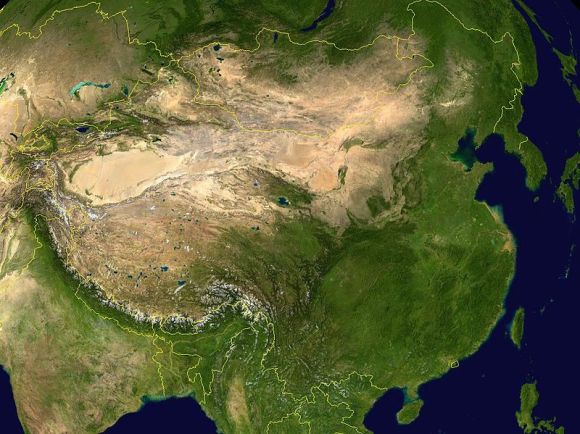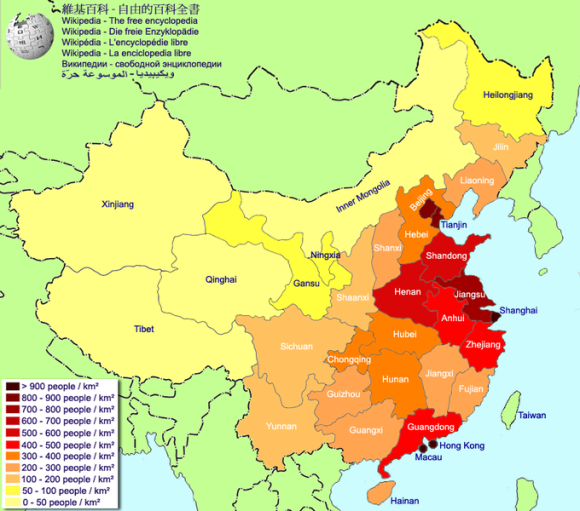
It can be said that the power of China lies in its massive population. This country holds around 1.3 billion people and nearly 20 percent of the world’s people. As such you might expect living there to be a tight squeeze.
However, according to 2010 census figures of the populations of each Chinese Province, Autonomous Region, and Direct Controlled Municipality, the nation with the most people still has quite a bit of space in parts.
First, looking at this map of population densities it would seem that most people are in the highly urbanized eastern part of the country.
Looking at the straight populations though, it’s Guangdong that comes out on top with 104,303,132 people. In the world there are only twelve countries with more than 100 million people, and if Guangdong had seceded from China it would join the club becoming the 12th and knocking the Philippines down to 13th (according to some sources). This would also bring India and China to nearly the same population according to some estimates.
1) China (minus Guangdong) (1,200,000,000)
2) India (1,200,000,000)
3) USA (317,000,000)
4) Indonesia (237,000,000)
5) Brazil (192,000,000)
6) Pakistan (183,000,000)
7) Nigeria (170,000,000)
8) Bangladesh (150,000,000)
9) Russia (143,000,000)
10) Japan (127,000,000)
11) Mexico (118,000,000)
12) Guangdong (104,000,000)
13) Philippines (103,000,000)
*NOTE: These figures are only rough estimates taken from a variety of sources.*
As expected, most of the top 10 regions for population can be found in the eastern part of the China. One exception is Sichuan which came in fourth with 80,418,200 people, but is located in the central part of the country.
Although Guangdong is a relatively large province, it’s still fairly small for its sheer number of people. It’s not quite as cozy as the island of Male, but to put it in perspective, if the entire world population were to move into Russia, it would still be around 25% more spacious than Guangdong is now – a lot colder, but more spacious.
On the other end of the list, we have the Tibet Autonomous Region with a measly 3,002,166 people. The area is around three times that of all Japan and yet has fewer people than the 23 wards of Tokyo (8,967,665). It’s also more sparsely populated than Canada.
So if you’re looking for some real estate in China, don’t worry because there are still acres to be had – just as long as you’re into mountains and deserts. It’s also comforting to know that in the event of a massive climate shift causing uninhabitable temperatures around the equator, we can all move into Russia and get by much like they do in Guangdong now. Thanks statistics!
Source: Nico Nico News (Japanese)
Here are the full rankings for each province, autonomous region, and direct controlled city. Hong Kong and Macau are not included.
1) Guangdong (104,303,132)
2) Shandong (95,793,100)
3) Henan (94,023,567)
4) Sichuan (80,418,200)
5) Jiangsu (78,659,903)
6) Hebei (71,854,202)
7) Hunan (65,683,722)
8) Anhui (59,501,000)
9) Hubei (57,237,740)
10) Zhejiang (54,426,900)
11) Guangxi (46,026,600)
12) Yunnan (45, 966,000)
13) Jiangxi (44,567,475)
14) Liaoning (43,746,323)
15) Heilongjiang (38,312,224)
16) Shaanxi (37,327,378)
17) Shanxi (35,712,111)
18) Guizhou (34,746,468)
19) Fujian (34,714, 835)
20) Chongqing (28,846,200)
21) Inner Mongolia (27,706,321)
22) Jilin (27,462,297)
23) Gansu (25,575,254)
24) Shanghai (23,019,148)
25) Xinjiang (21,813,334)
26) Beijing (19,612,000)
27) Tianjin (12, 938,224)
28) Hainan (8,671,518)
29) Ningxia (6,301,350)
30) Qinghai (5,626,722)
31) Tibet (3,002,166)


 UNICEF: Japan safest country to have a baby
UNICEF: Japan safest country to have a baby Guangzhou City to allow co-workers and neighbors to give consent for other people’s organ donations
Guangzhou City to allow co-workers and neighbors to give consent for other people’s organ donations Online “Population Decrease Map” of Japan paints a bleak, womanless future for the country
Online “Population Decrease Map” of Japan paints a bleak, womanless future for the country iPhone 6 launch keeps Chinese customs officials busy as they seize hundreds of smuggled units
iPhone 6 launch keeps Chinese customs officials busy as they seize hundreds of smuggled units J-pop megastar Utada Hikaru announces first concert tour in 12 years
J-pop megastar Utada Hikaru announces first concert tour in 12 years Japan’s new difficult-to-drink-from beer glass protects your liver, but it’s a brutal experience
Japan’s new difficult-to-drink-from beer glass protects your liver, but it’s a brutal experience How to order snacks on a Shinkansen bullet train in Japan
How to order snacks on a Shinkansen bullet train in Japan New samurai glasses are Japan’s latest weird must-have souvenir
New samurai glasses are Japan’s latest weird must-have souvenir “Deflowering” services for virgin women are now a thing in Japan, apparently
“Deflowering” services for virgin women are now a thing in Japan, apparently Doraemon found buried at sea as scene from 1993 anime becomes real life【Photos】
Doraemon found buried at sea as scene from 1993 anime becomes real life【Photos】 Burger King Japan suddenly adds Dr. Pepper and Dr. Pepper floats to its menu nationwide
Burger King Japan suddenly adds Dr. Pepper and Dr. Pepper floats to its menu nationwide Hello, cosmetics! Clinique teams up with Hello Kitty this summer for first-time collaboration
Hello, cosmetics! Clinique teams up with Hello Kitty this summer for first-time collaboration Princesses, fruits, and blacksmiths: Study reveals the 30 most unusual family names in Japan
Princesses, fruits, and blacksmiths: Study reveals the 30 most unusual family names in Japan High-fashion Totoro cuddle purse is like an elegant stroll in the forest【Photos】
High-fashion Totoro cuddle purse is like an elegant stroll in the forest【Photos】 Demon Slayer: Kimetsu no Yaiba gets new roller coaster attractions and food at Universal Studios Japan
Demon Slayer: Kimetsu no Yaiba gets new roller coaster attractions and food at Universal Studios Japan Nintendo history you can feel – Super NES, N64, and GameCube controllers become capsule toys
Nintendo history you can feel – Super NES, N64, and GameCube controllers become capsule toys “The most Delicious Cup Noodle in history” – Japan’s French Cup Noodle wins our heart【Taste test】
“The most Delicious Cup Noodle in history” – Japan’s French Cup Noodle wins our heart【Taste test】 Starbucks releases a cute Frappuccino and Unicorn Cake…but not in Japan
Starbucks releases a cute Frappuccino and Unicorn Cake…but not in Japan Kyoto Tower mascot termination reveals dark side behind cute Japanese characters
Kyoto Tower mascot termination reveals dark side behind cute Japanese characters McDonald’s Japan’s Soft Twist Tower: A phantom ice cream only sold at select branches
McDonald’s Japan’s Soft Twist Tower: A phantom ice cream only sold at select branches Yabai Ramen: What makes this Japanese ramen so dangerous?
Yabai Ramen: What makes this Japanese ramen so dangerous? Finally! Nintendo Japan expands Switch 8-bit controller sales to everybody, Online member or not
Finally! Nintendo Japan expands Switch 8-bit controller sales to everybody, Online member or not Japanese government wants to build luxury resorts in all national parks for foreign tourists
Japanese government wants to build luxury resorts in all national parks for foreign tourists To combat declining birth rate, Japan to begin offering “Breeding Visas” to foreigners
To combat declining birth rate, Japan to begin offering “Breeding Visas” to foreigners 10 things you should buy at 7-Eleven in Japan
10 things you should buy at 7-Eleven in Japan Studio Ghibli releases anime heroine cosplay dresses that are super comfy to wear
Studio Ghibli releases anime heroine cosplay dresses that are super comfy to wear Woman charged for driving suitcase without a license in Osaka
Woman charged for driving suitcase without a license in Osaka Studio Ghibli unveils My Neighbour Totoro miniature house model
Studio Ghibli unveils My Neighbour Totoro miniature house model Kyoto experiencing problems with foreign tourists not paying for bus fares, but not on purpose
Kyoto experiencing problems with foreign tourists not paying for bus fares, but not on purpose Fighting mild hunger with a Japanese soda that turns into jelly in the stomach【Taste test】
Fighting mild hunger with a Japanese soda that turns into jelly in the stomach【Taste test】 Studio Ghibli’s Howl’s Moving Castle tapestry unveiled in Japan for first time
Studio Ghibli’s Howl’s Moving Castle tapestry unveiled in Japan for first time McDonald’s new Happy Meals offer up cute and practical Sanrio lifestyle goods
McDonald’s new Happy Meals offer up cute and practical Sanrio lifestyle goods Sales of Japan’s most convenient train ticket/shopping payment cards suspended indefinitely
Sales of Japan’s most convenient train ticket/shopping payment cards suspended indefinitely Sold-out Studio Ghibli desktop humidifiers are back so Totoro can help you through the dry season
Sold-out Studio Ghibli desktop humidifiers are back so Totoro can help you through the dry season Japanese government to make first change to romanization spelling rules since the 1950s
Japanese government to make first change to romanization spelling rules since the 1950s Foreigner’s request for help in Tokyo makes us sad for the state of society
Foreigner’s request for help in Tokyo makes us sad for the state of society Ghibli founders Toshio Suzuki and Hayao Miyazaki contribute to Japanese whisky Totoro label design
Ghibli founders Toshio Suzuki and Hayao Miyazaki contribute to Japanese whisky Totoro label design Tokyo’s most famous Starbucks is closed
Tokyo’s most famous Starbucks is closed 1,007 Dancing Robots Smash Guinness World Record
1,007 Dancing Robots Smash Guinness World Record In pictures: Everyday life in China and Hong Kong, 1868-1872【Photos】
In pictures: Everyday life in China and Hong Kong, 1868-1872【Photos】 Here are the 15 most amazing home made robots, tanks, and vehicles in China
Here are the 15 most amazing home made robots, tanks, and vehicles in China The dirty reason China can’t always tell North Korea what to do
The dirty reason China can’t always tell North Korea what to do Japanese government to give all 18-and-under residents 100,000 yen… here’s why that’s bad news
Japanese government to give all 18-and-under residents 100,000 yen… here’s why that’s bad news J-pop royalty Ayumi Hamasaki teams up with Club Harie for collaborative baum cakes
J-pop royalty Ayumi Hamasaki teams up with Club Harie for collaborative baum cakes Japan’s foreign population reaches historic milestone following largest-ever single-year surge
Japan’s foreign population reaches historic milestone following largest-ever single-year surge This is a pretty worrying chart for China’s demographic future
This is a pretty worrying chart for China’s demographic future Anime idols going abroad as Love Live! movie announced for release in U.S., 12 other territories
Anime idols going abroad as Love Live! movie announced for release in U.S., 12 other territories Can you guess the most densely populated city in the world?
Can you guess the most densely populated city in the world? 16 facts about China that will blow your mind
16 facts about China that will blow your mind New self-driving buses testing across Japan let you pay with your face
New self-driving buses testing across Japan let you pay with your face Japanese readers rave about new book illustrating differences between Kanto and Kansai regions
Japanese readers rave about new book illustrating differences between Kanto and Kansai regions Chinese businessman sets his sights on driving Disney Resort out of Shanghai
Chinese businessman sets his sights on driving Disney Resort out of Shanghai
Leave a Reply